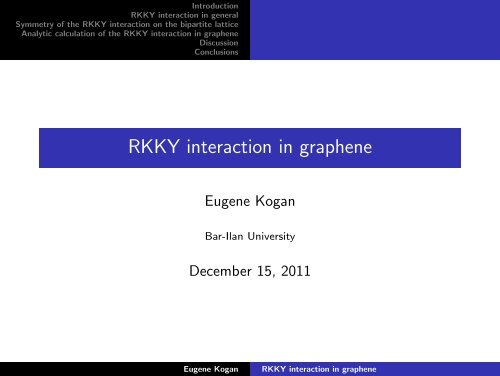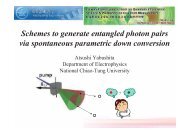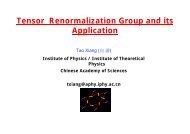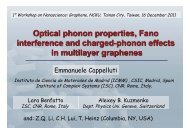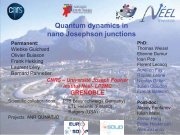RKKY interaction in graphene
RKKY interaction in graphene
RKKY interaction in graphene
You also want an ePaper? Increase the reach of your titles
YUMPU automatically turns print PDFs into web optimized ePapers that Google loves.
Introduction<br />
<strong>RKKY</strong> <strong><strong>in</strong>teraction</strong> <strong>in</strong> general<br />
Symmetry of the <strong>RKKY</strong> <strong><strong>in</strong>teraction</strong> on the bipartite lattice<br />
Analytic calculation of the <strong>RKKY</strong> <strong><strong>in</strong>teraction</strong> <strong>in</strong> <strong>graphene</strong><br />
Discussion<br />
Conclusions<br />
<strong>RKKY</strong> <strong><strong>in</strong>teraction</strong> <strong>in</strong> <strong>graphene</strong><br />
Eugene Kogan<br />
Bar-Ilan University<br />
December 15, 2011<br />
Eugene Kogan<br />
<strong>RKKY</strong> <strong><strong>in</strong>teraction</strong> <strong>in</strong> <strong>graphene</strong>
Introduction<br />
<strong>RKKY</strong> <strong><strong>in</strong>teraction</strong> <strong>in</strong> general<br />
Symmetry of the <strong>RKKY</strong> <strong><strong>in</strong>teraction</strong> on the bipartite lattice<br />
Analytic calculation of the <strong>RKKY</strong> <strong><strong>in</strong>teraction</strong> <strong>in</strong> <strong>graphene</strong><br />
Discussion<br />
Conclusions<br />
Graphene 2004<br />
Eugene Kogan<br />
<strong>RKKY</strong> <strong><strong>in</strong>teraction</strong> <strong>in</strong> <strong>graphene</strong>
Introduction<br />
<strong>RKKY</strong> <strong><strong>in</strong>teraction</strong> <strong>in</strong> general<br />
Symmetry of the <strong>RKKY</strong> <strong><strong>in</strong>teraction</strong> on the bipartite lattice<br />
Analytic calculation of the <strong>RKKY</strong> <strong><strong>in</strong>teraction</strong> <strong>in</strong> <strong>graphene</strong><br />
Discussion<br />
Conclusions<br />
Graphene 2010<br />
Eugene Kogan<br />
<strong>RKKY</strong> <strong><strong>in</strong>teraction</strong> <strong>in</strong> <strong>graphene</strong>
Introduction<br />
<strong>RKKY</strong> <strong><strong>in</strong>teraction</strong> <strong>in</strong> general<br />
Symmetry of the <strong>RKKY</strong> <strong><strong>in</strong>teraction</strong> on the bipartite lattice<br />
Analytic calculation of the <strong>RKKY</strong> <strong><strong>in</strong>teraction</strong> <strong>in</strong> <strong>graphene</strong><br />
Discussion<br />
Conclusions<br />
Graphene sublattices and Brillou<strong>in</strong> zone<br />
Eugene Kogan<br />
<strong>RKKY</strong> <strong><strong>in</strong>teraction</strong> <strong>in</strong> <strong>graphene</strong>
Introduction<br />
<strong>RKKY</strong> <strong><strong>in</strong>teraction</strong> <strong>in</strong> general<br />
Symmetry of the <strong>RKKY</strong> <strong><strong>in</strong>teraction</strong> on the bipartite lattice<br />
Analytic calculation of the <strong>RKKY</strong> <strong><strong>in</strong>teraction</strong> <strong>in</strong> <strong>graphene</strong><br />
Discussion<br />
Conclusions<br />
Bond<strong>in</strong>g and anti-bond<strong>in</strong>g<br />
In isolated form, carbon has six electrons <strong>in</strong> the orbital<br />
configuration 1s 2 2s 2 2p 2 . When arranged <strong>in</strong> the honeycomb<br />
crystal, two electrons rema<strong>in</strong> <strong>in</strong> the core 1s orbital, while the other<br />
orbitals hybridize, form<strong>in</strong>g three sp 2 bonds and one p z orbital. The<br />
sp 2 orbitals form the σ band, which conta<strong>in</strong>s three localized<br />
electrons. The bond<strong>in</strong>g configuration among the p z orbitals of<br />
different lattice sites generates a valence band, or π-band,<br />
conta<strong>in</strong><strong>in</strong>g one electron, whereas the antibond<strong>in</strong>g configuration<br />
generates the conduction band (π ∗ ), which is empty.<br />
Eugene Kogan<br />
<strong>RKKY</strong> <strong><strong>in</strong>teraction</strong> <strong>in</strong> <strong>graphene</strong>
Introduction<br />
<strong>RKKY</strong> <strong><strong>in</strong>teraction</strong> <strong>in</strong> general<br />
Symmetry of the <strong>RKKY</strong> <strong><strong>in</strong>teraction</strong> on the bipartite lattice<br />
Analytic calculation of the <strong>RKKY</strong> <strong><strong>in</strong>teraction</strong> <strong>in</strong> <strong>graphene</strong><br />
Discussion<br />
Conclusions<br />
Dirac po<strong>in</strong>ts and dispersion law<br />
Figure: Brillou<strong>in</strong> zone centered around the Γ po<strong>in</strong>t and Dirac cone<br />
result<strong>in</strong>g from the l<strong>in</strong>earization of tight-b<strong>in</strong>d<strong>in</strong>g spectrum around the K<br />
po<strong>in</strong>ts (blue circles).<br />
Eugene Kogan<br />
<strong>RKKY</strong> <strong><strong>in</strong>teraction</strong> <strong>in</strong> <strong>graphene</strong>
Introduction<br />
<strong>RKKY</strong> <strong><strong>in</strong>teraction</strong> <strong>in</strong> general<br />
Symmetry of the <strong>RKKY</strong> <strong><strong>in</strong>teraction</strong> on the bipartite lattice<br />
Analytic calculation of the <strong>RKKY</strong> <strong><strong>in</strong>teraction</strong> <strong>in</strong> <strong>graphene</strong><br />
Discussion<br />
Conclusions<br />
Nearest and next–nearest neighbor hopp<strong>in</strong>g model<br />
H =<br />
∣<br />
−t ′ ∑ e ik·a −t ∑ δ i<br />
e ik·δ ∣<br />
i ∣∣∣<br />
−t ∑ δ i<br />
e −ik·δ i<br />
−t ′ ∑ e ik·a ,<br />
Eugene Kogan<br />
<strong>RKKY</strong> <strong><strong>in</strong>teraction</strong> <strong>in</strong> <strong>graphene</strong>
Introduction<br />
<strong>RKKY</strong> <strong><strong>in</strong>teraction</strong> <strong>in</strong> general<br />
Symmetry of the <strong>RKKY</strong> <strong><strong>in</strong>teraction</strong> on the bipartite lattice<br />
Analytic calculation of the <strong>RKKY</strong> <strong><strong>in</strong>teraction</strong> <strong>in</strong> <strong>graphene</strong><br />
Discussion<br />
Conclusions<br />
Dispersion law<br />
E ± (k) = ±t √ 3 + f (k) − t ′ f (k),<br />
f (k) = ∑ (√ )<br />
(√ ) ( )<br />
e ik·δ i 3 3<br />
= 2 cos 3ky a + 4 cos<br />
2 k y a cos<br />
2 k y a .<br />
δ i<br />
At the vertices of the Brillou<strong>in</strong> zone<br />
( ) ( 2π<br />
K =<br />
3a , 2π<br />
2π<br />
3 √ , K ′ =<br />
3a<br />
3a , − 2π )<br />
3 √ 3a<br />
f (K) = f (K ′ ) = −3,<br />
hence the Brillou<strong>in</strong> zones merge there.<br />
Eugene Kogan<br />
<strong>RKKY</strong> <strong><strong>in</strong>teraction</strong> <strong>in</strong> <strong>graphene</strong>
Introduction<br />
<strong>RKKY</strong> <strong><strong>in</strong>teraction</strong> <strong>in</strong> general<br />
Symmetry of the <strong>RKKY</strong> <strong><strong>in</strong>teraction</strong> on the bipartite lattice<br />
Analytic calculation of the <strong>RKKY</strong> <strong><strong>in</strong>teraction</strong> <strong>in</strong> <strong>graphene</strong><br />
Discussion<br />
Conclusions<br />
The general tight–b<strong>in</strong>d<strong>in</strong>g Hamiltonian<br />
H =<br />
∣<br />
− ∑ a t′ (a)e ik·a − ∑ ∣<br />
a<br />
t(a + δ)eik·(a+δ) ∣∣∣<br />
− ∑ a t∗ (a + δ)e −ik·(a+δ) − ∑ a t′ (a)e ik·a ,<br />
where a is an arbitrary lattice vector, and δ is any (fixed) vector<br />
connect<strong>in</strong>g two sites of different sub-lattices. The dispersion law<br />
thus is given by equation<br />
where<br />
F (E, k) =<br />
[<br />
E + ∑ a<br />
F (E, k) = 0,<br />
] 2 ∣ t ′ (a)e ik·a ∑<br />
∣∣∣∣<br />
2<br />
−<br />
t(a + δ)e ik·(a+δ)<br />
∣<br />
a<br />
Eugene Kogan<br />
<strong>RKKY</strong> <strong><strong>in</strong>teraction</strong> <strong>in</strong> <strong>graphene</strong>
Introduction<br />
<strong>RKKY</strong> <strong><strong>in</strong>teraction</strong> <strong>in</strong> general<br />
Symmetry of the <strong>RKKY</strong> <strong><strong>in</strong>teraction</strong> on the bipartite lattice<br />
Analytic calculation of the <strong>RKKY</strong> <strong><strong>in</strong>teraction</strong> <strong>in</strong> <strong>graphene</strong><br />
Discussion<br />
Conclusions<br />
Merg<strong>in</strong>g of the zones<br />
∑<br />
t(a + δ)e iK·(a+δ) = 0<br />
a<br />
t(a + δ) realizes the A 1 (unit) representation of the po<strong>in</strong>t<br />
symmetry group C 3v , and e iK·(a+δ) , e iK′·(a+δ) realize E<br />
representation of the group.<br />
On the other hand, generally<br />
∑<br />
t ′ (a)e iK·a ≠ 0. (1)<br />
a<br />
This is because t ′ (a) realizes the A 1 representation of the po<strong>in</strong>t<br />
symmetry group C 6v , and e iK·a , e iK′·a realize representation<br />
A 1 + B 1 .<br />
Eugene Kogan<br />
<strong>RKKY</strong> <strong><strong>in</strong>teraction</strong> <strong>in</strong> <strong>graphene</strong>
Introduction<br />
<strong>RKKY</strong> <strong><strong>in</strong>teraction</strong> <strong>in</strong> general<br />
Symmetry of the <strong>RKKY</strong> <strong><strong>in</strong>teraction</strong> on the bipartite lattice<br />
Analytic calculation of the <strong>RKKY</strong> <strong><strong>in</strong>teraction</strong> <strong>in</strong> <strong>graphene</strong><br />
Discussion<br />
Conclusions<br />
L<strong>in</strong>ear spectrum<br />
In mathematics the Dirac po<strong>in</strong>ts are called conical po<strong>in</strong>ts of the<br />
surface; if the surface is given by<br />
F (E, k) = 0,<br />
the conditions for the conical po<strong>in</strong>ts are<br />
∂F<br />
∂E = 0,<br />
∂F<br />
∂k = 0.<br />
F (E, k) =<br />
[<br />
E + ∑ a<br />
] 2 ∣ t ′ (a)e ik·a ∑<br />
∣∣∣∣<br />
2<br />
−<br />
t(a + δ)e ik·(a+δ)<br />
∣<br />
a<br />
Eugene Kogan<br />
<strong>RKKY</strong> <strong><strong>in</strong>teraction</strong> <strong>in</strong> <strong>graphene</strong>
Introduction<br />
<strong>RKKY</strong> <strong><strong>in</strong>teraction</strong> <strong>in</strong> general<br />
Symmetry of the <strong>RKKY</strong> <strong><strong>in</strong>teraction</strong> on the bipartite lattice<br />
Analytic calculation of the <strong>RKKY</strong> <strong><strong>in</strong>teraction</strong> <strong>in</strong> <strong>graphene</strong><br />
Discussion<br />
Conclusions<br />
History of <strong>RKKY</strong><br />
<strong>RKKY</strong> stands for Ruderman-Kittel-Kasuya-Yosida and refers to a<br />
coupl<strong>in</strong>g mechanism of nuclear magnetic moments or magnetic<br />
ions <strong>in</strong> a normal metal by means of an exchange <strong><strong>in</strong>teraction</strong> with<br />
the conduction electrons. The <strong>RKKY</strong> <strong><strong>in</strong>teraction</strong> was orig<strong>in</strong>ally<br />
proposed as a means of expla<strong>in</strong><strong>in</strong>g unusually broad nuclear sp<strong>in</strong><br />
resonance l<strong>in</strong>es that had been observed <strong>in</strong> natural metallic silver.<br />
Eugene Kogan<br />
<strong>RKKY</strong> <strong><strong>in</strong>teraction</strong> <strong>in</strong> <strong>graphene</strong>
Introduction<br />
<strong>RKKY</strong> <strong><strong>in</strong>teraction</strong> <strong>in</strong> general<br />
Symmetry of the <strong>RKKY</strong> <strong><strong>in</strong>teraction</strong> on the bipartite lattice<br />
Analytic calculation of the <strong>RKKY</strong> <strong><strong>in</strong>teraction</strong> <strong>in</strong> <strong>graphene</strong><br />
Discussion<br />
Conclusions<br />
Physical system<br />
Eugene Kogan<br />
<strong>RKKY</strong> <strong><strong>in</strong>teraction</strong> <strong>in</strong> <strong>graphene</strong>
Introduction<br />
<strong>RKKY</strong> <strong><strong>in</strong>teraction</strong> <strong>in</strong> general<br />
Symmetry of the <strong>RKKY</strong> <strong><strong>in</strong>teraction</strong> on the bipartite lattice<br />
Analytic calculation of the <strong>RKKY</strong> <strong><strong>in</strong>teraction</strong> <strong>in</strong> <strong>graphene</strong><br />
Discussion<br />
Conclusions<br />
<strong>RKKY</strong> <strong><strong>in</strong>teraction</strong> <strong>in</strong> metals<br />
Total Hamiltonian<br />
H T = H − JS i·s i − JS j·s j ,<br />
where H is the Hamiltonian of free electrons, S i is the sp<strong>in</strong>s of the<br />
impurity and s i is the sp<strong>in</strong> of it<strong>in</strong>erant electrons at site i.<br />
H <strong>RKKY</strong> =<br />
J 2<br />
µ 0 (gµ B ) 2 2k F R ij cos(2k F R ij ) − s<strong>in</strong>(2k F R ij )<br />
(2k F R ij ) 4 S i·S j<br />
Eugene Kogan<br />
<strong>RKKY</strong> <strong><strong>in</strong>teraction</strong> <strong>in</strong> <strong>graphene</strong>
Introduction<br />
<strong>RKKY</strong> <strong><strong>in</strong>teraction</strong> <strong>in</strong> general<br />
Symmetry of the <strong>RKKY</strong> <strong><strong>in</strong>teraction</strong> on the bipartite lattice<br />
Analytic calculation of the <strong>RKKY</strong> <strong><strong>in</strong>teraction</strong> <strong>in</strong> <strong>graphene</strong><br />
Discussion<br />
Conclusions<br />
Adatom<br />
Figure: Graphene honeycomb latice with an adatom sitt<strong>in</strong>g on top of<br />
carbon atom.<br />
Eugene Kogan<br />
<strong>RKKY</strong> <strong><strong>in</strong>teraction</strong> <strong>in</strong> <strong>graphene</strong>
Introduction<br />
<strong>RKKY</strong> <strong><strong>in</strong>teraction</strong> <strong>in</strong> general<br />
Symmetry of the <strong>RKKY</strong> <strong><strong>in</strong>teraction</strong> on the bipartite lattice<br />
Analytic calculation of the <strong>RKKY</strong> <strong><strong>in</strong>teraction</strong> <strong>in</strong> <strong>graphene</strong><br />
Discussion<br />
Conclusions<br />
The correction to the thermodynamic potential<br />
H T = H + H <strong>in</strong>t<br />
{<br />
}<br />
∆Ω = −T ln ⟨S⟩ ≡ −T ln tr S · e −H/T /Z<br />
where the S–matrix is<br />
S = exp<br />
{<br />
−<br />
∫ 1/T<br />
0<br />
H <strong>in</strong>t (τ)dτ<br />
}<br />
H <strong>in</strong>t (τ) = e τ(H−µ ˆN) H <strong>in</strong>t e −τ(H−µ ˆN)<br />
Eugene Kogan<br />
<strong>RKKY</strong> <strong><strong>in</strong>teraction</strong> <strong>in</strong> <strong>graphene</strong>
Introduction<br />
<strong>RKKY</strong> <strong><strong>in</strong>teraction</strong> <strong>in</strong> general<br />
Symmetry of the <strong>RKKY</strong> <strong><strong>in</strong>teraction</strong> on the bipartite lattice<br />
Analytic calculation of the <strong>RKKY</strong> <strong><strong>in</strong>teraction</strong> <strong>in</strong> <strong>graphene</strong><br />
Discussion<br />
Conclusions<br />
Second order term<br />
H <strong>in</strong>t = −JS i·s i − JS j·s j ,<br />
s i = 1 2 c† iα σ αβc iβ ,<br />
the second order term of the expansion is<br />
∆Ω = J2 T<br />
4<br />
∫ 1/T ∫ 1/T<br />
0<br />
0<br />
∑<br />
S i·σ αβ S j·σ γδ<br />
αβγδ<br />
dτ 1 dτ 2<br />
⟨<br />
T τ<br />
{c † iα (τ 1)c iβ (τ 1 )c † jγ (τ 2)c jδ (τ 2 )<br />
}⟩<br />
.<br />
Eugene Kogan<br />
<strong>RKKY</strong> <strong><strong>in</strong>teraction</strong> <strong>in</strong> <strong>graphene</strong>
Introduction<br />
<strong>RKKY</strong> <strong><strong>in</strong>teraction</strong> <strong>in</strong> general<br />
Symmetry of the <strong>RKKY</strong> <strong><strong>in</strong>teraction</strong> on the bipartite lattice<br />
Analytic calculation of the <strong>RKKY</strong> <strong><strong>in</strong>teraction</strong> <strong>in</strong> <strong>graphene</strong><br />
Discussion<br />
Conclusions<br />
Wick theorem<br />
For non-<strong>in</strong>teract<strong>in</strong>g electrons<br />
{<br />
}⟩<br />
⟨T τ c † iα (τ 1)c iβ (τ 1 )c † jγ (τ 2)c jδ (τ 2 )<br />
{<br />
}⟩ {<br />
}⟩<br />
= −<br />
⟨T τ c iβ (τ 1 )c † jγ (τ 2)<br />
⟨T τ c jδ (τ 2 )c † iα (τ 1)<br />
{<br />
}⟩<br />
G βγ (i, j, τ 1 − τ 2 ) = −<br />
⟨T τ c iβ (τ 1 )c † jγ (τ 2)<br />
⟨<br />
}⟩<br />
= −δ βγ T τ<br />
{c i (τ 1 )c † j (τ 2)<br />
is the Matsubara Green’s function.<br />
Eugene Kogan<br />
<strong>RKKY</strong> <strong><strong>in</strong>teraction</strong> <strong>in</strong> <strong>graphene</strong>
Introduction<br />
<strong>RKKY</strong> <strong><strong>in</strong>teraction</strong> <strong>in</strong> general<br />
Symmetry of the <strong>RKKY</strong> <strong><strong>in</strong>teraction</strong> on the bipartite lattice<br />
Analytic calculation of the <strong>RKKY</strong> <strong><strong>in</strong>teraction</strong> <strong>in</strong> <strong>graphene</strong><br />
Discussion<br />
Conclusions<br />
Sp<strong>in</strong> <strong>in</strong>dices summation<br />
∑<br />
αβγδ<br />
S i·σ αβ S j·σ γδ δ βγ δ δα = ∑ αβ<br />
S i·σ αβ S j·σ βα = S i·S j ,<br />
∆Ω = −J 2 χ ij S i·S j ,<br />
where<br />
χ ij = − 1 4<br />
∫ 1/T<br />
0<br />
G(i, j; τ)G(j, i; −τ)dτ<br />
Eugene Kogan<br />
<strong>RKKY</strong> <strong><strong>in</strong>teraction</strong> <strong>in</strong> <strong>graphene</strong>
Introduction<br />
<strong>RKKY</strong> <strong><strong>in</strong>teraction</strong> <strong>in</strong> general<br />
Symmetry of the <strong>RKKY</strong> <strong><strong>in</strong>teraction</strong> on the bipartite lattice<br />
Analytic calculation of the <strong>RKKY</strong> <strong><strong>in</strong>teraction</strong> <strong>in</strong> <strong>graphene</strong><br />
Discussion<br />
Conclusions<br />
<strong>RKKY</strong> <strong><strong>in</strong>teraction</strong><br />
Thus we obta<strong>in</strong><br />
H <strong>RKKY</strong> = −J 2 χ ij S i·S j ,<br />
where χ ij is the free electrons static real space sp<strong>in</strong> susceptibility.<br />
Eugene Kogan<br />
<strong>RKKY</strong> <strong><strong>in</strong>teraction</strong> <strong>in</strong> <strong>graphene</strong>
Introduction<br />
<strong>RKKY</strong> <strong><strong>in</strong>teraction</strong> <strong>in</strong> general<br />
Symmetry of the <strong>RKKY</strong> <strong><strong>in</strong>teraction</strong> on the bipartite lattice<br />
Analytic calculation of the <strong>RKKY</strong> <strong><strong>in</strong>teraction</strong> <strong>in</strong> <strong>graphene</strong><br />
Discussion<br />
Conclusions<br />
Matsubara Green’s function<br />
The Green’s function can be easily written down us<strong>in</strong>g<br />
representation of eigenvectors and eigenvalues of the operator H<br />
It is<br />
(H − E n ) u n = 0.<br />
G(i, j; τ) = ∑ n<br />
u ∗ n(i)u n (j)e −ξ nτ<br />
{ − (1 − nF (ξ n )) , τ > 0<br />
n F (ξ n ), τ < 0 ,<br />
where ξ n = E n − µ, and n F (ξ) = ( e βξ + 1 ) −1 is the Fermi<br />
distribution function.<br />
Eugene Kogan<br />
<strong>RKKY</strong> <strong><strong>in</strong>teraction</strong> <strong>in</strong> <strong>graphene</strong>
Introduction<br />
<strong>RKKY</strong> <strong><strong>in</strong>teraction</strong> <strong>in</strong> general<br />
Symmetry of the <strong>RKKY</strong> <strong><strong>in</strong>teraction</strong> on the bipartite lattice<br />
Analytic calculation of the <strong>RKKY</strong> <strong><strong>in</strong>teraction</strong> <strong>in</strong> <strong>graphene</strong><br />
Discussion<br />
Conclusions<br />
Hamiltonian of the bipartite lattice<br />
Bipartite lattice we’ll understand <strong>in</strong> the sense, that all the sites can<br />
be divided <strong>in</strong> two sublattices, and there is only <strong>in</strong>ter–sublattice<br />
hopp<strong>in</strong>g (no <strong>in</strong>tra–sublattice hopp<strong>in</strong>g). Thus the Hamiltonian H <strong>in</strong><br />
matrix representation is<br />
H =<br />
( 0 T<br />
T † 0<br />
)<br />
,<br />
where T is some matrix N × M.<br />
Eugene Kogan<br />
<strong>RKKY</strong> <strong><strong>in</strong>teraction</strong> <strong>in</strong> <strong>graphene</strong>
Introduction<br />
<strong>RKKY</strong> <strong><strong>in</strong>teraction</strong> <strong>in</strong> general<br />
Symmetry of the <strong>RKKY</strong> <strong><strong>in</strong>teraction</strong> on the bipartite lattice<br />
Analytic calculation of the <strong>RKKY</strong> <strong><strong>in</strong>teraction</strong> <strong>in</strong> <strong>graphene</strong><br />
Discussion<br />
Conclusions<br />
Graphene lattice<br />
Graphene lattice consists of two sublattices<br />
H = ∑ <br />
t ij c † i c j.<br />
Eugene Kogan<br />
<strong>RKKY</strong> <strong><strong>in</strong>teraction</strong> <strong>in</strong> <strong>graphene</strong>
Introduction<br />
<strong>RKKY</strong> <strong><strong>in</strong>teraction</strong> <strong>in</strong> general<br />
Symmetry of the <strong>RKKY</strong> <strong><strong>in</strong>teraction</strong> on the bipartite lattice<br />
Analytic calculation of the <strong>RKKY</strong> <strong><strong>in</strong>teraction</strong> <strong>in</strong> <strong>graphene</strong><br />
Discussion<br />
Conclusions<br />
Mathematic prelim<strong>in</strong>aries<br />
Secular equation<br />
˜H =<br />
( 0 B<br />
C 0<br />
∣ −EI<br />
C<br />
)<br />
.<br />
B<br />
−EI ∣ = 0.<br />
Determ<strong>in</strong>ant of the block matrix<br />
∣ A B<br />
C D ∣ = |A| ∣ ∣D − CA −1 B ∣ .<br />
∣<br />
∣E 2 I M×M − CB ∣ ∣ = 0.<br />
Eugene Kogan<br />
<strong>RKKY</strong> <strong><strong>in</strong>teraction</strong> <strong>in</strong> <strong>graphene</strong>
Introduction<br />
<strong>RKKY</strong> <strong><strong>in</strong>teraction</strong> <strong>in</strong> general<br />
Symmetry of the <strong>RKKY</strong> <strong><strong>in</strong>teraction</strong> on the bipartite lattice<br />
Analytic calculation of the <strong>RKKY</strong> <strong><strong>in</strong>teraction</strong> <strong>in</strong> <strong>graphene</strong><br />
Discussion<br />
Conclusions<br />
Symmetry of the spectrum and the wave functions<br />
The spectrum is symmetric, that is non-zero eigenvalues of the<br />
matrix H are present <strong>in</strong> pares (E, −E).<br />
Eigenfunctions equation<br />
( −En I T<br />
T † −E n I<br />
Hence<br />
u n (i) = ±u n (i),<br />
)<br />
u n = 0,<br />
where u n is the eigenfunction correspond<strong>in</strong>g to E n and u¯n is the<br />
eigenfunction correspond<strong>in</strong>g to −E n , and <strong>in</strong> the r.h.s. there is + if<br />
the site i belongs to one sublattice, and there is - if the site<br />
belongs to the opposite sublattice.<br />
Eugene Kogan<br />
<strong>RKKY</strong> <strong><strong>in</strong>teraction</strong> <strong>in</strong> <strong>graphene</strong>
Introduction<br />
<strong>RKKY</strong> <strong><strong>in</strong>teraction</strong> <strong>in</strong> general<br />
Symmetry of the <strong>RKKY</strong> <strong><strong>in</strong>teraction</strong> on the bipartite lattice<br />
Analytic calculation of the <strong>RKKY</strong> <strong><strong>in</strong>teraction</strong> <strong>in</strong> <strong>graphene</strong><br />
Discussion<br />
Conclusions<br />
Symmetry of the Green’s function<br />
G(i, j; τ) = ∑ n<br />
{<br />
un(i)u ∗ n (j)e −ξnτ − (1 − nF (ξ<br />
×<br />
n )) , τ > 0<br />
n F (ξ n ), τ < 0 ,<br />
u n (i) = ±u n (i),<br />
For µ = 0<br />
n F (ξ m ) = 1 − n F (ξ m ).<br />
Eugene Kogan<br />
<strong>RKKY</strong> <strong><strong>in</strong>teraction</strong> <strong>in</strong> <strong>graphene</strong>
Introduction<br />
<strong>RKKY</strong> <strong><strong>in</strong>teraction</strong> <strong>in</strong> general<br />
Symmetry of the <strong>RKKY</strong> <strong><strong>in</strong>teraction</strong> on the bipartite lattice<br />
Analytic calculation of the <strong>RKKY</strong> <strong><strong>in</strong>teraction</strong> <strong>in</strong> <strong>graphene</strong><br />
Discussion<br />
Conclusions<br />
Symmetry of different terms <strong>in</strong> the Green’s function<br />
G(i, j; τ) = ∑ n<br />
{<br />
un(i)u ∗ n (j)e −ξnτ − (1 − nF (ξ<br />
×<br />
n )) , τ > 0<br />
n F (ξ n ), τ < 0 ,<br />
The terms with non-zero energy are pairwise antisymmetric (with<br />
respect to simultaneous transformation τ → −τ, i ⇄ j and<br />
complex conjugation) for the sites i and j belong<strong>in</strong>g to the same<br />
sublattice, and pairwise symmetric for the sites i and j belong<strong>in</strong>g<br />
to opposite sublattices. The term (terms) with E = 0 is<br />
antisymmetric with respect to the above mentioned<br />
transformation, no matter which sublattices the sites belong to.<br />
Eugene Kogan<br />
<strong>RKKY</strong> <strong><strong>in</strong>teraction</strong> <strong>in</strong> <strong>graphene</strong>
Introduction<br />
<strong>RKKY</strong> <strong><strong>in</strong>teraction</strong> <strong>in</strong> general<br />
Symmetry of the <strong>RKKY</strong> <strong><strong>in</strong>teraction</strong> on the bipartite lattice<br />
Analytic calculation of the <strong>RKKY</strong> <strong><strong>in</strong>teraction</strong> <strong>in</strong> <strong>graphene</strong><br />
Discussion<br />
Conclusions<br />
Symmetry of the Green’s function<br />
For the sites i and j belong<strong>in</strong>g to the same sublattice<br />
G(j, i; −τ) = −G ∗ (i, j; τ).<br />
For the sites i and j belong<strong>in</strong>g to different sublattices<br />
G(j, i; −τ) = G ∗ (i, j; τ),<br />
provided there are no zero energy states, or we can neglect there<br />
contribution to the Green’s function.<br />
Eugene Kogan<br />
<strong>RKKY</strong> <strong><strong>in</strong>teraction</strong> <strong>in</strong> <strong>graphene</strong>
Introduction<br />
<strong>RKKY</strong> <strong><strong>in</strong>teraction</strong> <strong>in</strong> general<br />
Symmetry of the <strong>RKKY</strong> <strong><strong>in</strong>teraction</strong> on the bipartite lattice<br />
Analytic calculation of the <strong>RKKY</strong> <strong><strong>in</strong>teraction</strong> <strong>in</strong> <strong>graphene</strong><br />
Discussion<br />
Conclusions<br />
Symmetry of the <strong>RKKY</strong> <strong><strong>in</strong>teraction</strong><br />
G(j, i; −τ) = ∓G ∗ (i, j; τ).<br />
χ ij = − 1 4<br />
∫ 1/T<br />
0<br />
G(i, j; τ)G(j, i; −τ)dτ<br />
The <strong>RKKY</strong> <strong><strong>in</strong>teraction</strong> on the bipartite lattice at half fill<strong>in</strong>g is<br />
ferromagnetic between impurities on the same sublattice and is<br />
antiferromagnetic between impurities on opposite sublattices<br />
(under the above stated restriction).<br />
Eugene Kogan<br />
<strong>RKKY</strong> <strong><strong>in</strong>teraction</strong> <strong>in</strong> <strong>graphene</strong>
Introduction<br />
<strong>RKKY</strong> <strong><strong>in</strong>teraction</strong> <strong>in</strong> general<br />
Symmetry of the <strong>RKKY</strong> <strong><strong>in</strong>teraction</strong> on the bipartite lattice<br />
Analytic calculation of the <strong>RKKY</strong> <strong><strong>in</strong>teraction</strong> <strong>in</strong> <strong>graphene</strong><br />
Discussion<br />
Conclusions<br />
Graphene wave functions<br />
The wave function for the momentum around Dirac po<strong>in</strong>ts<br />
ψ ν,K (k) = 1 √<br />
2<br />
( e<br />
−iθ k /2<br />
νe iθ k/2<br />
)<br />
, (2)<br />
ψ ν,K ′(k) = 1 √<br />
2<br />
( e<br />
iθ k /2<br />
νe −iθ k/2<br />
)<br />
, (3)<br />
where α = ±1 corresponds to electron and hole band respectively.<br />
Eugene Kogan<br />
<strong>RKKY</strong> <strong><strong>in</strong>teraction</strong> <strong>in</strong> <strong>graphene</strong>
Introduction<br />
<strong>RKKY</strong> <strong><strong>in</strong>teraction</strong> <strong>in</strong> general<br />
Symmetry of the <strong>RKKY</strong> <strong><strong>in</strong>teraction</strong> on the bipartite lattice<br />
Analytic calculation of the <strong>RKKY</strong> <strong><strong>in</strong>teraction</strong> <strong>in</strong> <strong>graphene</strong><br />
Discussion<br />
Conclusions<br />
Graphene Green’s functions<br />
G(i, j; τ) = ∑ n<br />
u ∗ n(i)u n (j)e −ξ nτ<br />
{ − (1 − nF (ξ n )) , τ > 0<br />
n F (ξ n ), τ < 0 ,<br />
the ∑ n<br />
turns <strong>in</strong>to<br />
a2<br />
∫<br />
(2π) d 2 p<br />
2<br />
u n (i) = e ip·R i<br />
ψ p ,<br />
where ψ p is the appropriate component of sp<strong>in</strong>or electron<br />
wave-function (depend<strong>in</strong>g upon which sublattice the magnetic<br />
adatom belongs to) <strong>in</strong> momentum representation.<br />
Eugene Kogan<br />
<strong>RKKY</strong> <strong><strong>in</strong>teraction</strong> <strong>in</strong> <strong>graphene</strong>
Introduction<br />
<strong>RKKY</strong> <strong><strong>in</strong>teraction</strong> <strong>in</strong> general<br />
Symmetry of the <strong>RKKY</strong> <strong><strong>in</strong>teraction</strong> on the bipartite lattice<br />
Analytic calculation of the <strong>RKKY</strong> <strong><strong>in</strong>teraction</strong> <strong>in</strong> <strong>graphene</strong><br />
Discussion<br />
Conclusions<br />
Graphene Green’s functions<br />
For i and j belong<strong>in</strong>g to the same sublattice<br />
G AA (i, j; τ > 0) = − 1 2<br />
[e iK·R ij<br />
+ e iK′·R ij<br />
]<br />
a 2 ∫<br />
(2π) 2<br />
d 2 ke ik·R ij −E +(k)τ ,<br />
and for i and j belong<strong>in</strong>g to different sublattices<br />
G AB (i, j; τ > 0) = 1 a 2 ∫<br />
2 (2π) 2 d 2 ke −E +(k)τ<br />
]<br />
×<br />
[e i(K+k)·R ij −iθ k<br />
+ e i(K′ +k)·R ij +iθ k<br />
.<br />
For τ < 0 we should change the sign of the Green’s functions and<br />
substitute E − for E + .<br />
Eugene Kogan<br />
<strong>RKKY</strong> <strong><strong>in</strong>teraction</strong> <strong>in</strong> <strong>graphene</strong>
Introduction<br />
<strong>RKKY</strong> <strong><strong>in</strong>teraction</strong> <strong>in</strong> general<br />
Symmetry of the <strong>RKKY</strong> <strong><strong>in</strong>teraction</strong> on the bipartite lattice<br />
Analytic calculation of the <strong>RKKY</strong> <strong><strong>in</strong>teraction</strong> <strong>in</strong> <strong>graphene</strong><br />
Discussion<br />
Conclusions<br />
Angle <strong>in</strong>tegration<br />
For isotropic dispersion law E(k) = E(k)<br />
∫<br />
∫ ∞<br />
d 2 ke ik·R ij −E(k)τ = dkkJ 0 (kR)e −E(k)τ<br />
0<br />
∫<br />
d 2 ke ik·R ij ±iθ k −E(k)τ =<br />
∫ ∞<br />
0<br />
dkkJ 1 (kR)e −E(k)τ<br />
(J 0 and J 1 are the Bessel function of zero and first order<br />
respectively.<br />
Eugene Kogan<br />
<strong>RKKY</strong> <strong><strong>in</strong>teraction</strong> <strong>in</strong> <strong>graphene</strong>
Introduction<br />
<strong>RKKY</strong> <strong><strong>in</strong>teraction</strong> <strong>in</strong> general<br />
Symmetry of the <strong>RKKY</strong> <strong><strong>in</strong>teraction</strong> on the bipartite lattice<br />
Analytic calculation of the <strong>RKKY</strong> <strong><strong>in</strong>teraction</strong> <strong>in</strong> <strong>graphene</strong><br />
Discussion<br />
Conclusions<br />
L<strong>in</strong>ear dispersion E ± (k) = ±v F k<br />
Us<strong>in</strong>g mathematical identity<br />
(√ ) ν<br />
∫ ∞<br />
x n−1 e −px J ν (cx)dx = (−1) n−1 −ν ∂n−1 p 2 + c 2 − p<br />
c<br />
∂p n−1 √ ,<br />
p 2 + c 2<br />
0<br />
after simple calculus we obta<strong>in</strong><br />
χ AA (R ij ) =<br />
a 4 [<br />
1 + cos((K − K ′<br />
256v F R 3 )·R ji ) ]<br />
χ AB (R ij ) = −<br />
3a4 [<br />
1 + cos((K − K ′<br />
256v F R 3 )·R ji − 2θ R ) ] ,<br />
where θ R is the angle between the vectors K − K ′ and R ij ).<br />
Eugene Kogan<br />
<strong>RKKY</strong> <strong><strong>in</strong>teraction</strong> <strong>in</strong> <strong>graphene</strong>
Introduction<br />
<strong>RKKY</strong> <strong><strong>in</strong>teraction</strong> <strong>in</strong> general<br />
Symmetry of the <strong>RKKY</strong> <strong><strong>in</strong>teraction</strong> on the bipartite lattice<br />
Analytic calculation of the <strong>RKKY</strong> <strong><strong>in</strong>teraction</strong> <strong>in</strong> <strong>graphene</strong><br />
Discussion<br />
Conclusions<br />
Bilayer <strong>graphene</strong>: Bernal (Ã − B) stack<strong>in</strong>g.<br />
Eugene Kogan<br />
<strong>RKKY</strong> <strong><strong>in</strong>teraction</strong> <strong>in</strong> <strong>graphene</strong>
Introduction<br />
<strong>RKKY</strong> <strong><strong>in</strong>teraction</strong> <strong>in</strong> general<br />
Symmetry of the <strong>RKKY</strong> <strong><strong>in</strong>teraction</strong> on the bipartite lattice<br />
Analytic calculation of the <strong>RKKY</strong> <strong><strong>in</strong>teraction</strong> <strong>in</strong> <strong>graphene</strong><br />
Discussion<br />
Conclusions<br />
Bilayer <strong>graphene</strong>: Bernal (Ã − B) stack<strong>in</strong>g.<br />
a) Top view of a <strong>graphene</strong> bilayer; white and black circles: top<br />
layer carbon atoms; gray and red: bottom layer.<br />
b) four-band spectrum of the bilayer, ±E γ (p), with γ = ± near the<br />
corner of the Brillou<strong>in</strong> zone.<br />
c) Brillou<strong>in</strong> zone with high symmetry po<strong>in</strong>ts.<br />
d) Illustration of the four band spectrum around the K po<strong>in</strong>t.<br />
Eugene Kogan<br />
<strong>RKKY</strong> <strong><strong>in</strong>teraction</strong> <strong>in</strong> <strong>graphene</strong>
Introduction<br />
<strong>RKKY</strong> <strong><strong>in</strong>teraction</strong> <strong>in</strong> general<br />
Symmetry of the <strong>RKKY</strong> <strong><strong>in</strong>teraction</strong> on the bipartite lattice<br />
Analytic calculation of the <strong>RKKY</strong> <strong><strong>in</strong>teraction</strong> <strong>in</strong> <strong>graphene</strong><br />
Discussion<br />
Conclusions<br />
Low–energy modes<br />
The low–energy modes are localized on A and ˜B sites, we consider<br />
<strong>RKKY</strong> <strong><strong>in</strong>teraction</strong> of the magnetic adatoms sit<strong>in</strong>g on top of carbon<br />
atom <strong>in</strong> A and/or ˜B sites.<br />
and wave functions<br />
E ± (k) = ± k2<br />
2m<br />
ψ ν,K (k) =<br />
ψ ν,K ′(k) =<br />
1 √<br />
2<br />
( e<br />
−iθ k<br />
νe iθ k<br />
1 √<br />
2<br />
( e<br />
iθ k<br />
νe −iθ k<br />
)<br />
)<br />
.<br />
Eugene Kogan<br />
<strong>RKKY</strong> <strong><strong>in</strong>teraction</strong> <strong>in</strong> <strong>graphene</strong>
Introduction<br />
<strong>RKKY</strong> <strong><strong>in</strong>teraction</strong> <strong>in</strong> general<br />
Symmetry of the <strong>RKKY</strong> <strong><strong>in</strong>teraction</strong> on the bipartite lattice<br />
Analytic calculation of the <strong>RKKY</strong> <strong><strong>in</strong>teraction</strong> <strong>in</strong> <strong>graphene</strong><br />
Discussion<br />
Conclusions<br />
<strong>RKKY</strong> <strong><strong>in</strong>teraction</strong> <strong>in</strong> bilayer <strong>graphene</strong><br />
∫ ∞<br />
0<br />
J 0 (x) exp(−px 2 )xdx = 1 (<br />
2p exp − 1 )<br />
.<br />
4p<br />
After simple calculus we obta<strong>in</strong><br />
χ AA (R ji ) =<br />
ma2<br />
16π 2 R 2 [<br />
1 + cos((K − K ′ )·R ji ) ] .<br />
Eugene Kogan<br />
<strong>RKKY</strong> <strong><strong>in</strong>teraction</strong> <strong>in</strong> <strong>graphene</strong>
Introduction<br />
<strong>RKKY</strong> <strong><strong>in</strong>teraction</strong> <strong>in</strong> general<br />
Symmetry of the <strong>RKKY</strong> <strong><strong>in</strong>teraction</strong> on the bipartite lattice<br />
Analytic calculation of the <strong>RKKY</strong> <strong><strong>in</strong>teraction</strong> <strong>in</strong> <strong>graphene</strong><br />
Discussion<br />
Conclusions<br />
Frequency representation of Matsubara Green’s function<br />
χ ij = T 4<br />
∑<br />
un(i)u ∗ m (i)u n (j)um(j) ∑ ∗<br />
n,m<br />
ω<br />
1 1<br />
iω − ξ n iω − ξ m<br />
where ω = πT (2l + 1) (l is an <strong>in</strong>teger) is Matsubara frequency.<br />
χ ij = 1 4<br />
∑<br />
n,m<br />
u ∗ n(i)u m (i)u n (j)u ∗ m(j) n F (ξ m ) − n F (ξ n )<br />
ξ n − ξ m<br />
Eugene Kogan<br />
<strong>RKKY</strong> <strong><strong>in</strong>teraction</strong> <strong>in</strong> <strong>graphene</strong>
Introduction<br />
<strong>RKKY</strong> <strong><strong>in</strong>teraction</strong> <strong>in</strong> general<br />
Symmetry of the <strong>RKKY</strong> <strong><strong>in</strong>teraction</strong> on the bipartite lattice<br />
Analytic calculation of the <strong>RKKY</strong> <strong><strong>in</strong>teraction</strong> <strong>in</strong> <strong>graphene</strong><br />
Discussion<br />
Conclusions<br />
The way the analytic calculations shouldn’t be done<br />
χ(q) = ∑ νν ′ ,p<br />
M ν,ν ′ ,p,q<br />
n F [E ν ′(p + q)] − n F [E ν (p)]<br />
,<br />
E ν (p) − E ν ′(p + q)<br />
where E ν (p) is the <strong>graphene</strong> spectrum, and ν = ±1 labels the<br />
conduction and valence band.<br />
χ (R ij ) =<br />
∫<br />
a2<br />
(2π) 2<br />
d 2 qχ (q) e iq·R ij<br />
.<br />
Eugene Kogan<br />
<strong>RKKY</strong> <strong><strong>in</strong>teraction</strong> <strong>in</strong> <strong>graphene</strong>
Introduction<br />
<strong>RKKY</strong> <strong><strong>in</strong>teraction</strong> <strong>in</strong> general<br />
Symmetry of the <strong>RKKY</strong> <strong><strong>in</strong>teraction</strong> on the bipartite lattice<br />
Analytic calculation of the <strong>RKKY</strong> <strong><strong>in</strong>teraction</strong> <strong>in</strong> <strong>graphene</strong><br />
Discussion<br />
Conclusions<br />
The way the analytic calculations can be done<br />
χ AA a 4 [<br />
(R ij ) = 1 + cos((K − K ′<br />
4π 2 v F R 3 )·R ij ) ]<br />
∫ ∞<br />
0<br />
dxxJ 0 (x)<br />
∫ ∞<br />
0<br />
dx ′ x ′ J 0 (x ′ 1<br />
)<br />
x + x ′<br />
χ AB (R ij ) = −<br />
a4 [<br />
1 + cos((K − K ′<br />
4π 2 v F R 3 )·R ij ) ]<br />
∫ ∞<br />
0<br />
dxxJ 1 (x)<br />
∫ ∞<br />
0<br />
dx ′ x ′ J 1 (x ′ 1<br />
)<br />
x + x ′ .<br />
Eugene Kogan<br />
<strong>RKKY</strong> <strong><strong>in</strong>teraction</strong> <strong>in</strong> <strong>graphene</strong>
Introduction<br />
<strong>RKKY</strong> <strong><strong>in</strong>teraction</strong> <strong>in</strong> general<br />
Symmetry of the <strong>RKKY</strong> <strong><strong>in</strong>teraction</strong> on the bipartite lattice<br />
Analytic calculation of the <strong>RKKY</strong> <strong><strong>in</strong>teraction</strong> <strong>in</strong> <strong>graphene</strong><br />
Discussion<br />
Conclusions<br />
Convergence of the <strong>in</strong>tegrals<br />
∫ ∞<br />
0<br />
x ν<br />
x + z J ν(cx)dx =<br />
πzν<br />
2 cos νπ [H −ν(cz) − Y −ν (cz)],<br />
H ν (z) is the Struve function and Y ν (z) is the Neumann function<br />
∫<br />
π ∞<br />
[<br />
dxx 2 J 0 (x) Y 0 (x) − H 0 (x) + 2 ]<br />
2 0<br />
πx<br />
∫<br />
π ∞<br />
dxx 2 J 1 (x)[Y −1 (x) − H −1 (x)].<br />
2<br />
0<br />
The divergence of the <strong>in</strong>tegrals is guaranteed by the asymptotics<br />
1<br />
( x<br />
) ν−1 (<br />
H ν (x) − Y ν (x) → √ ( )<br />
πΓ ν +<br />
1 + O (x/2)<br />
ν−3 ) .<br />
2<br />
2<br />
Eugene Kogan<br />
<strong>RKKY</strong> <strong><strong>in</strong>teraction</strong> <strong>in</strong> <strong>graphene</strong>
Introduction<br />
<strong>RKKY</strong> <strong><strong>in</strong>teraction</strong> <strong>in</strong> general<br />
Symmetry of the <strong>RKKY</strong> <strong><strong>in</strong>teraction</strong> on the bipartite lattice<br />
Analytic calculation of the <strong>RKKY</strong> <strong><strong>in</strong>teraction</strong> <strong>in</strong> <strong>graphene</strong><br />
Discussion<br />
Conclusions<br />
Adatom positions<br />
For the case of substitutional impurities<br />
χ S AS A<br />
(R ij ) = X S AS A<br />
v F R 7 [<br />
1 + cos((K − K ′ )·R ij ) ]<br />
χ S AS B<br />
(R ij ) = − X S AS B<br />
v F R 7 [<br />
1 − cos((K − K ′ )·R ij − 6θ R ) ] .<br />
Eugene Kogan<br />
<strong>RKKY</strong> <strong><strong>in</strong>teraction</strong> <strong>in</strong> <strong>graphene</strong>
Introduction<br />
<strong>RKKY</strong> <strong><strong>in</strong>teraction</strong> <strong>in</strong> general<br />
Symmetry of the <strong>RKKY</strong> <strong><strong>in</strong>teraction</strong> on the bipartite lattice<br />
Analytic calculation of the <strong>RKKY</strong> <strong><strong>in</strong>teraction</strong> <strong>in</strong> <strong>graphene</strong><br />
Discussion<br />
Conclusions<br />
From Anderson to Kondo model<br />
Figure: Intersection of the Dirac cone spectrum, E(k) = ±v|k|, with the<br />
localized level E f = ε 0 : (b) ε 0 > 0, (c) ε 0 < 0.<br />
H hyb =<br />
∑ (<br />
)<br />
vi λ c † iα f λα + h.c. ,<br />
λ,α,i∈P<br />
H pd = −<br />
∑<br />
λ,α,β,i,j∈P<br />
Jv λ<br />
i vj<br />
λ<br />
∗<br />
S · σαβ c † iα c jβ.<br />
Eugene Kogan<br />
<strong>RKKY</strong> <strong><strong>in</strong>teraction</strong> <strong>in</strong> <strong>graphene</strong>
Introduction<br />
<strong>RKKY</strong> <strong><strong>in</strong>teraction</strong> <strong>in</strong> general<br />
Symmetry of the <strong>RKKY</strong> <strong><strong>in</strong>teraction</strong> on the bipartite lattice<br />
Analytic calculation of the <strong>RKKY</strong> <strong><strong>in</strong>teraction</strong> <strong>in</strong> <strong>graphene</strong><br />
Discussion<br />
Conclusions<br />
The <strong>RKKY</strong> <strong><strong>in</strong>teraction</strong> on the bipartite lattice at half fill<strong>in</strong>g is<br />
ferromagnetic between impurities on the same sublattice and is<br />
antiferromagnetic between impurities on opposite sublattices. The<br />
latter is true, provided there are no zero energy states..<br />
H <strong>RKKY</strong> = −J 2 χ ij S i·S j ,<br />
χ AA (R ij ) =<br />
a 4 [<br />
1 + cos((K − K ′<br />
256v F R 3 )·R ji ) ]<br />
χ AB (R ij ) = −<br />
3a4 [<br />
1 + cos((K − K ′<br />
256v F R 3 )·R ji − 2θ R ) ] .<br />
Eugene Kogan<br />
<strong>RKKY</strong> <strong><strong>in</strong>teraction</strong> <strong>in</strong> <strong>graphene</strong>


